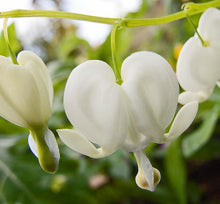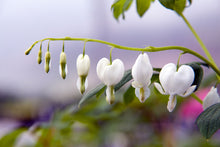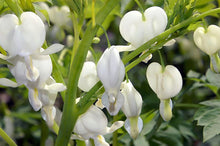Dicentra spectabilis 'Alba' is the white old-fashioned Bleeding Heart. Every bit as charming as the pink form, 'Alba' forms large, bushy clumps of powdery-light green foliage comprised of cut or lobed leaves on fleshy stems. In late spring, chains of puffy, white, heart-shaped flowers dangle beneath the arching, leafless stems. Blooms are exquisitely delicate, and the white gives an entirely different character to the plant. The blooms make delightful additions to fresh bouquets, lasting about 2 weeks in a vase. In cooler climates with adequate moisture, the bloom time may be extended into early summer. Like so many white varieties, it is slightly less vigorous than its pink cousin, which doesn't diminish its garden value a bit.
Botanical name: Dicentra spectabilis 'Alba'
Form: Perennial
Hardiness Zone: 4-9
Flower Color: White,
Foliage Type: Blue-green fern-leaf
Bloom time: Late spring-early summer
Height: 12 inches
Spread: 12 inches
Light requirements: Full to partial shade
Plant depth: 1 inch of soil over the root crown
See "Growing Tips" for more detailed instructions
Form: Perennial
Hardiness Zone: 4-9
Flower Color: White,
Foliage Type: Blue-green fern-leaf
Bloom time: Late spring-early summer
Height: 12 inches
Spread: 12 inches
Light requirements: Full to partial shade
Plant depth: 1 inch of soil over the root crown
See "Growing Tips" for more detailed instructions
Tips and Growing Instructions
Visit our How-To Cultivation Library for more growing tips.
These delicate-looking plants are actually sturdy and trouble-free additions to the perennial border or woodland garden. An old-fashioned beauty, Dicentra spectabilis bears arching stems of pendant, puffy heart-shaped blooms in pink or white and can grow to three feet tall and as wide where happy. The longer-blooming, shorter forms boast attractive green to blue-green foliage that is lovely in the garden from spring to fall. Both types make excellent cut flowers.
Bareroot Dicentra spectabilis should be planted with the crown 2″ below the soil line, but the crown of smaller bareroot varieties should be 1″ below the soil line. Bleeding Heart thrives in evenly moist, rich soil in partial to full shade, although flowering is best with morning sun and afternoon shade. Consistent watering is best for all; D. spectabilis will go dormant during dry conditions in summer. A two-inch layer of mulch will help buffer soil moisture and keep the ground cooler. A slightly acidic soil (pH 6.0 to 6.5) is ideal, but plants will tolerate a pH up to 7.5. Apply compost or a general purpose, granular fertilizer in spring.
Dicentra is occasionally bothered by slugs and snails, but this is rarely a serious problem. If grown in poorly drained, wet soil, the crowns of the plants may rot. Avoid these soils and allow good air circulation. Keep mulch several inches away from the base of the plants.
Dicentra is lovely with other denizens of light shade such as Aquilegia, Ferns, Tiarella, Campanula, Alchemilla, Phlox divaricata, and Pulmonaria, and truly enlivens woodland gardens. Plant D. spectabilis with Hosta or spreading perennial Geraniums, or fill in with annuals when this plant goes dormant in summer. The smaller varieties of Dicentra will bloom right up until frost in temperate climates, especially if old flower stems are removed. In areas with very hot summers, flowering may stop but will resume with cooler weather. Regular removal of yellowing foliage will keep plants looking fresh.
If desired, plants can be gingerly divided in early spring: gently separate the brittle roots, replanting vigorous pieces from the outer edge of the plant. Remove dead foliage after a killing frost in autumn, or anytime it becomes unattractive. A light mulch after the ground freezes will protect from winter heaving.
Visit our How-To Cultivation Library for more growing tips.
These delicate-looking plants are actually sturdy and trouble-free additions to the perennial border or woodland garden. An old-fashioned beauty, Dicentra spectabilis bears arching stems of pendant, puffy heart-shaped blooms in pink or white and can grow to three feet tall and as wide where happy. The longer-blooming, shorter forms boast attractive green to blue-green foliage that is lovely in the garden from spring to fall. Both types make excellent cut flowers.
Bareroot Dicentra spectabilis should be planted with the crown 2″ below the soil line, but the crown of smaller bareroot varieties should be 1″ below the soil line. Bleeding Heart thrives in evenly moist, rich soil in partial to full shade, although flowering is best with morning sun and afternoon shade. Consistent watering is best for all; D. spectabilis will go dormant during dry conditions in summer. A two-inch layer of mulch will help buffer soil moisture and keep the ground cooler. A slightly acidic soil (pH 6.0 to 6.5) is ideal, but plants will tolerate a pH up to 7.5. Apply compost or a general purpose, granular fertilizer in spring.
Dicentra is occasionally bothered by slugs and snails, but this is rarely a serious problem. If grown in poorly drained, wet soil, the crowns of the plants may rot. Avoid these soils and allow good air circulation. Keep mulch several inches away from the base of the plants.
Dicentra is lovely with other denizens of light shade such as Aquilegia, Ferns, Tiarella, Campanula, Alchemilla, Phlox divaricata, and Pulmonaria, and truly enlivens woodland gardens. Plant D. spectabilis with Hosta or spreading perennial Geraniums, or fill in with annuals when this plant goes dormant in summer. The smaller varieties of Dicentra will bloom right up until frost in temperate climates, especially if old flower stems are removed. In areas with very hot summers, flowering may stop but will resume with cooler weather. Regular removal of yellowing foliage will keep plants looking fresh.
If desired, plants can be gingerly divided in early spring: gently separate the brittle roots, replanting vigorous pieces from the outer edge of the plant. Remove dead foliage after a killing frost in autumn, or anytime it becomes unattractive. A light mulch after the ground freezes will protect from winter heaving.
Shipping
Sorry, we do not ship outside the U.S. or to Hawaii due to agricultural restrictions.
We guarantee safe arrival of healthy bulbs, that varieties will be true-to-name, and will grow if planted as instructed, subject to the limitations described in our Shipping and Returns Policy.
We begin shipping our bulbs in mid-February through Spring. Despite what you may have heard, Spring planting of bulbs is not a bad thing, and in fact, there are many advantages to planting in Spring. Visit our Spring Planting page to learn more. Upon arriving, your bulbs and most of your perennials may show signs of growth such as green leaves and sprouts - this is okay and transportation during this time should not harm the plants.
All bulbs and perennials should be planted in your garden as soon as possible to ensure the best success. If you must delay planting, open the bags to permit air circulation and place them out of direct sunlight in a cool, well-ventilated room. Do not place the bulbs where they can freeze. If you have the space, storing the bulbs in the refrigerator is another excellent way to “hold them” prior to planting. If you choose this method of storing your bulbs, be sure not to store fruit with them, as this is detrimental to bulbs.
Plant outdoors when the ground is no longer frozen and the conditions have improved for your zone.
If you have any questions or concerns our customer service team would be glad to help you at any time. Please use our contact form, email us at support@lilypadbulbs.com, or call us at 541-671-3196.






